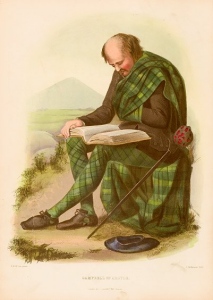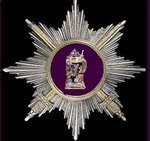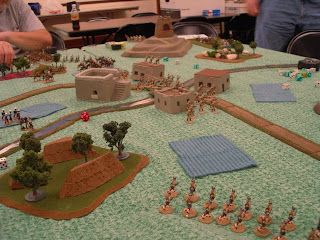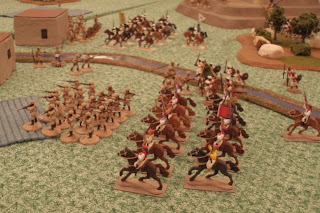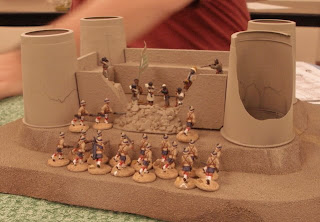 Larry Brom giving out instructions prior to the start of the game.
Larry Brom giving out instructions prior to the start of the game.The scenario was a meeting engagement somewhere in the woods in Pennsylvania or New York between two balanced forces. Each side had two regular infantry units, one light gun, one ranger or couer de bois unit, two militia units, and three Indian units, plus a commander and and a second in command. I played on the British side.
 The British commander, gun, and the two regular infantry units (being played by bearskin hatted grenadiers) advance into a clearing between two wooded areas.
The British commander, gun, and the two regular infantry units (being played by bearskin hatted grenadiers) advance into a clearing between two wooded areas.For part of Larry's physical therapy after his various heart related illnesses, his daughters purchased a large selection of plastic coniferous and deciduous trees. Larry spent a good amount of time gluing these trees to out-of-date color sample chits and then adding some flocking to them. The overall effect was very nice as it amply simulated the North American wilderness.
 Seeing the French infantry in the open, the British allied Indians start to swarm them. But the plucky French withstood several Indian charges, although both units lost many fusiliers to the Indian's muskets, arrows, and tomahawks.
Seeing the French infantry in the open, the British allied Indians start to swarm them. But the plucky French withstood several Indian charges, although both units lost many fusiliers to the Indian's muskets, arrows, and tomahawks. The British infantry, on the other hand, thought that it could awe the French couer de bois and militia with its military splendor and advanced up a rise to "teach the Frogs a lesson." The gun and the couer de bois were better shots than the British anticipated - scratch one British unit!
The British infantry, on the other hand, thought that it could awe the French couer de bois and militia with its military splendor and advanced up a rise to "teach the Frogs a lesson." The gun and the couer de bois were better shots than the British anticipated - scratch one British unit! Two of the French allied Indian units try to stay concealed in a patch of woods, waiting for the British forces to come out in the open.
Two of the French allied Indian units try to stay concealed in a patch of woods, waiting for the British forces to come out in the open. Which they obligingly did, leading with a unit of green clad rangers and following with two militia units.
Which they obligingly did, leading with a unit of green clad rangers and following with two militia units. Meanwhile, the second British regular unit covers the right flank against a unit of French allied Indians deployed along a woodline. (The white ring denotes a casualty.)
Meanwhile, the second British regular unit covers the right flank against a unit of French allied Indians deployed along a woodline. (The white ring denotes a casualty.) The British allied Indians, now joined by a colonial militia unit, continue to harass the French regular infantry units, slowly wearing them down. But the French were also getting their licks in, killing a number of Indians with their disciplined musket fire.
The British allied Indians, now joined by a colonial militia unit, continue to harass the French regular infantry units, slowly wearing them down. But the French were also getting their licks in, killing a number of Indians with their disciplined musket fire. Beset by three enemy units (two militia and one Indian), the British regulars slowly withdraw. On the upper right, the British gun stands deserted as the lone surviving gunner has fled his post.
Beset by three enemy units (two militia and one Indian), the British regulars slowly withdraw. On the upper right, the British gun stands deserted as the lone surviving gunner has fled his post. A British allied Indian unit melees with the French regulars. They inflict some casualties but are forced to withdraw out of effective musket range of the French.
A British allied Indian unit melees with the French regulars. They inflict some casualties but are forced to withdraw out of effective musket range of the French. On the British left, the rangers and a unit of militia engage the French allied Indians and begin to force them back.
On the British left, the rangers and a unit of militia engage the French allied Indians and begin to force them back. While on the British right, the French allied Indians have completed circled the British regulars, forcing them to change facing and then charge with cold steel. They are joined by one of their allied Indian units. But the French allied Indians are too ferocious for the British infantry and the second unit is reduced to combat ineffectiveness.
While on the British right, the French allied Indians have completed circled the British regulars, forcing them to change facing and then charge with cold steel. They are joined by one of their allied Indian units. But the French allied Indians are too ferocious for the British infantry and the second unit is reduced to combat ineffectiveness.(The stand of four blue coated figures with the three white rings is the single British gunner striving to return to his gun. He makes it but is then shot by French militiamen before he can get the gun into action!)
 Finally the British allied Indians are able to get things coordinated and gang up on the French allied Indian unit that defeated the British regulars. They smash the French Indians and send the remnants fleeing the field.
Finally the British allied Indians are able to get things coordinated and gang up on the French allied Indian unit that defeated the British regulars. They smash the French Indians and send the remnants fleeing the field.But by then the British had lost too many troops and the French were declared the winners, with a captured British gun to take home as a trophy. Even though I was on the loosing side, I still had fun. The game played very quickly and easily. It should soon be available at Sergeants3.
